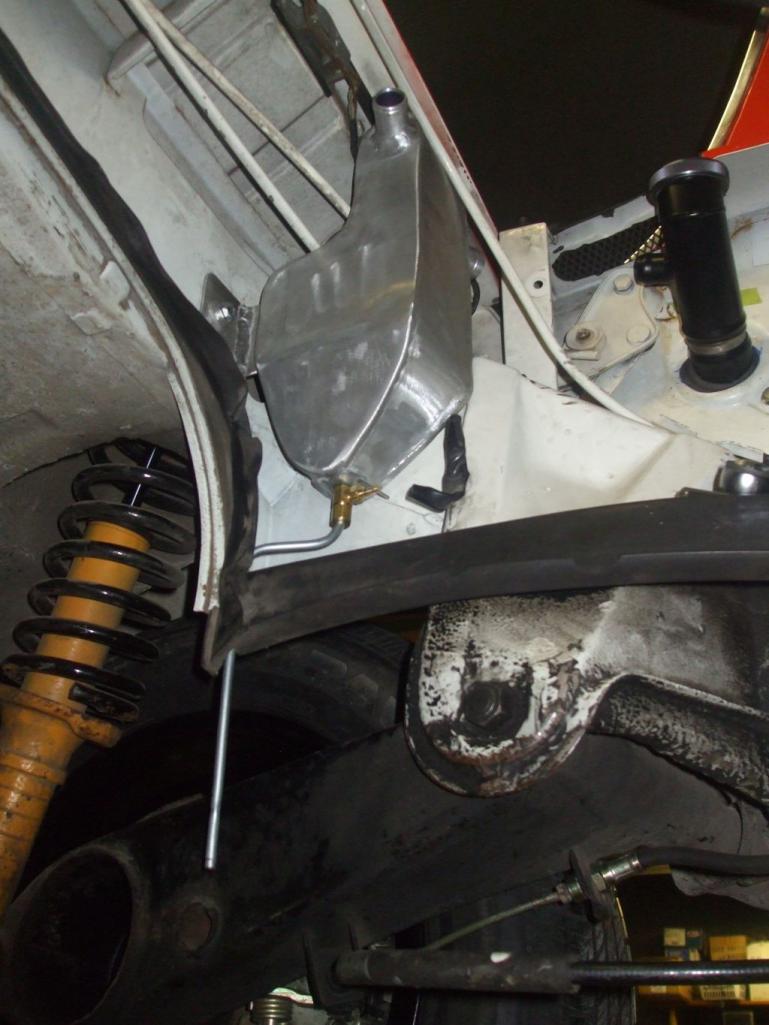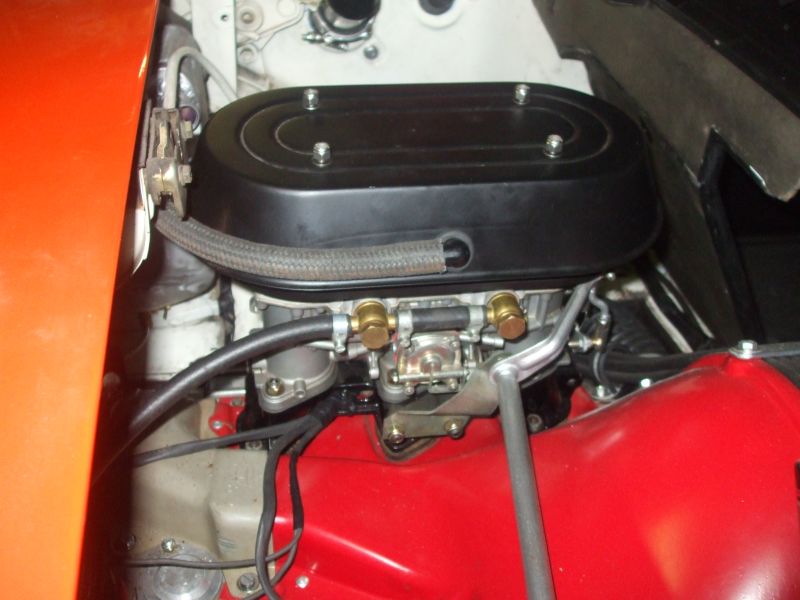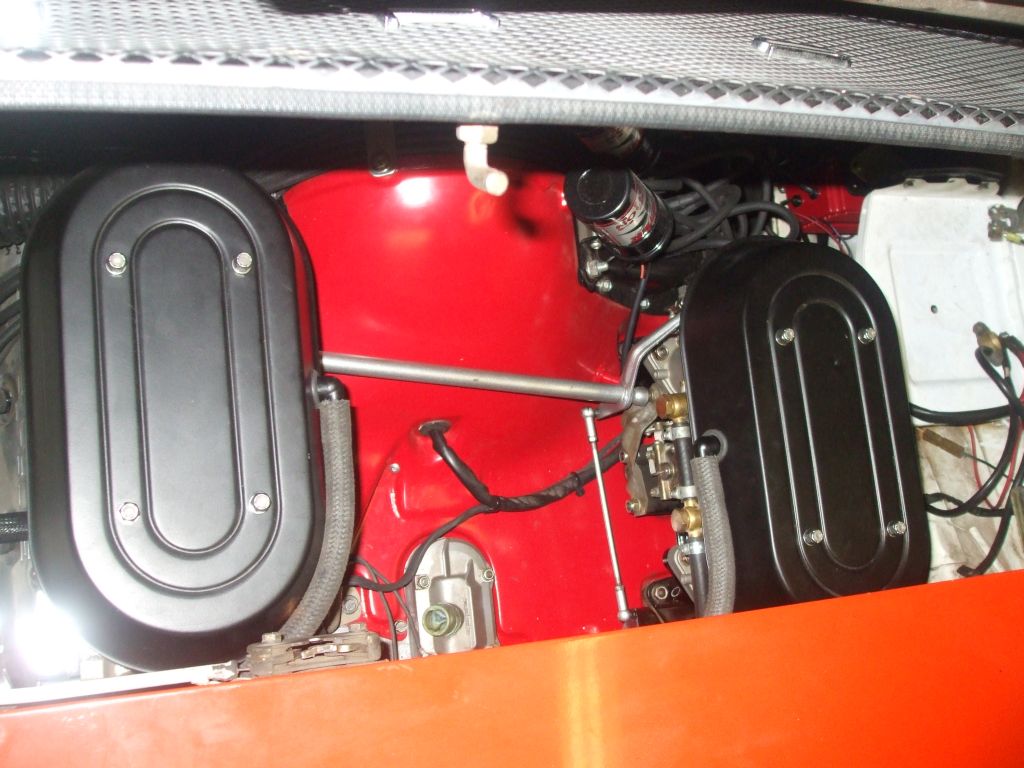 |
 |
 |
 |

|

|
|
|
|
|
|
Registered
Join Date: Aug 2018
Location: Australia
Posts: 10
|
My 70 911T is fitted with Webers with rainhats. Since I bought it, there has been a stench of burnt fuel / oil coming into the cabin which I put down to leaking oil return tubes and both the fuel vapor lines and oil vent line being lose (not connected to anything) in the engine compartment. I have since replaced all the known sources for leaks; new seals, hoses and O rings and all of the return tubes and seals. I also replaced the magnesium valve covers and have a new insulator ready to go. I have scrubbed and repainted the engine compartment and now I'm keen to sort out the vapor line routing as I put it all back together. I have an oil catch can I'm planning to use and I've figured out two possible line routing solutions.
Would really appreciate some feedback on these please. ALT 1 - Takes the breather line from the PCV outlet to the catch can then to the oil tank. I figured this would do the best job of separating oil from the vapor before returning it to the the oil tank but, the inlet size on the catch can is about 15mm which I'm concerned will not enable sufficient pressure release from the crank case and damage the rings. ALT 2 - Keeps the OEM routing from the PCV outlet and sends vapor from the tank to the catch can. Probably safer from a pressure POV but not as efficient in providing cleaner oil back to the tank / engine. Please feel free to contribute constructive advice. Cheers, 335 |
||
|
|
|
|
Registered
Join Date: Aug 2018
Location: Australia
Posts: 10
|
Hope you guys out there with Weber's and rain hats have some recommendations on this too please?
Cheers, 335 |
||
|
|
|
|
Registered
Join Date: Jul 2000
Location: So. Calif.
Posts: 19,910
|
Don't think the factory fuel vapor canister is designed to control blowby. There was a small hose from the filler pipe (?) to the airbox that provided some measure of crankcase breathing. It may have been barely adequate for normal driving. Beyond that, it would have sprayed a fine mist or more into the airbox. In addition, I don't think PAG ever installed a PCV valve in their early engines. Also, not familiar with the "PMO junction box". What is that supposed to do?
The most effective crankcase breathing system requires large diameter hose and enough area to help slow down the air velocity which contains oil, fuel, combustion by-products and moisture. Your Alt 1 drawing shows a catch can positioned between the crankcase breather outlet and the oil tank. This catch can in this location isn't recommended due to the high velocity and volume of blowby from the engine and the restricted flow. That system would test the integrity of engine gaskets since there's little volume or clear air path available. That green hose should instead be routed directly to the oil tank as shown in Alt 2. Alt 2 is closer. The upper portion of the oil tank provides a relatively large area for the high velocity blowby to dissipate. A catch can is then able to further separate the airflow. However, from the catch can, there are two options for relatively clean air to relieve case pressure: One is a., an exit hose to the engine intake via one or both air filter housings. Install adequately-sized hoses in that case. Catch can exit a works, but any liquid blowby ends up in the filtering media or back into the intake tract. The other, b., vents to atmosphere from the catch can, but can be problematic if the catch can doesn't adequately separate liquid from air and/or if the hose end points to an area near the rear tires. Venting unburnt combustion products into the atmosphere and/or to under-chassis parts is also problematic. If atmospheric venting is chosen, attach a breathable filter to act as a final fluid collector as crankcase air vents. Pick not your poison, but the next best option. Sherwood |
||
|
|
|
|
Puny Bird
Join Date: Nov 2002
Location: Port Hope (near Toronto) On, Canada
Posts: 4,566
|
The two systems need to be separate. Fuel vapor goes to a charcoal canister that gets blown in when you start the car. Some cans are metal but after '74 they're plastic.
You could run the smog hose to one carb and the vapour hose to the other hat, or you're going to have to drill holes in the hats for the vapour hoses. personally it only needs one hose, pick a side.
__________________
'74 Porsche 914, 3.0/6 '72 Porsche 914, 1.7, wife's summer DD '67 Bug, 2600cc T4,'67 Bus, 2.0 T1 Not putting miles on your car is like not having sex with your girlfriend, so she'll be more desirable to her next boyfriend. |
||
|
|
|
|
Registered
Join Date: Jul 2000
Location: So. Calif.
Posts: 19,910
|
Quote:
|
||
|
|
|
|
Registered
Join Date: Aug 2018
Location: Australia
Posts: 10
|
Thanks for your comments guys!
I have come to a similar conclusion with these two ideas. Here's a pic of the oil catch can I have purchased. This catch can is compact. At 300ml I found it fits nicely in the the outboard area of the engine compartment. You unscrew the lower body to empty collected fluid and it comes with a screw in dip stick and breather. The concern I had with this one is the plumbing sizes which I could drill and retap a few mm for a larger diameter fitting with out destroying it. 
|
||
|
|
|

|
|
Registered
Join Date: Aug 2018
Location: Australia
Posts: 10
|
This is what I'm calling the pmo junction. It has a large diameter inlet for connection to oil venting and a small diameter inlet for the fuel vapor. The outlet lines are two similar diameter to the FV inlet connect to the Weber (or PMO) hats.
Any thoughts on this? It will combine fuel and oil vapor rather than keeping separated as suggested. Would the set up in Alt 2 work ok so long as I can maintain the factory plumbing diameter into the catch can from the oil tank? I am presuming the breather on the catch can will provide pressure relief but will it be enough? How is that calculated? Thanks Pete  
|
||
|
|
|
|
Registered
Join Date: Jul 2000
Location: So. Calif.
Posts: 19,910
|
Quote:
Quote:
Any resistance to venting increases CC pressure which can lead to oil leaks. MHO - keep the fuel evap and crankcase venting systems separate. Sherwood |
||
|
|
|
|
Registered
Join Date: Aug 2018
Location: Australia
Posts: 10
|
Thanks for those comments Sherwood and Mark Henry.
Do you think a catch can like that with a breather and drain tube could completely eliminate the line running to the air cleaners? Alt 4... Cheers, Pete |
||
|
|
|
|
Registered
Join Date: Jul 2000
Location: So. Calif.
Posts: 19,910
|
As mentioned, you have a choice of venting the CC pressure to atmosphere or to the engine intake (from the catch can). However, you don't want to complete a path back to the crankcase.
|
||
|
|
|
|
Puny Bird
Join Date: Nov 2002
Location: Port Hope (near Toronto) On, Canada
Posts: 4,566
|
Quote:
This is why I will only vent to a carb/intake. No exceptions. My catch can/oil breather below has a petcock and a drain tube, so I can drain it every oil change. BTW this wasn't the final rendition of my catch can, I had to move the nipples slightly for the final fitting. 
__________________
'74 Porsche 914, 3.0/6 '72 Porsche 914, 1.7, wife's summer DD '67 Bug, 2600cc T4,'67 Bus, 2.0 T1 Not putting miles on your car is like not having sex with your girlfriend, so she'll be more desirable to her next boyfriend. Last edited by Mark Henry; 02-24-2021 at 08:04 AM.. |
||
|
|
|
|
Registered
|
Awesome post, eyeballing a set of weber 40IDA this week for my 79!
|
||
|
|
|
|
Registered
Join Date: Jul 2000
Location: So. Calif.
Posts: 19,910
|
The effectiveness of the catch can depends on the amount of blowby you have and how well the internal design separates liquid from air. Take a look at various cans on the market and see how each tackle the fluid/air separation objective. Some use a labyrinth of walls in the air space. Others use mesh or other material, and some use a combination of both. In addition, the inlet and outlet ports shouldn't be close to each other or point toward each other. What's inside your can?
If the engine's normal operating condition is high rpm and high G loads, then more attention has to be directed to this area. If it's a race car, you can route it anywhere you want to relieve CC pressure. |
||
|
|
|
|
Puny Bird
Join Date: Nov 2002
Location: Port Hope (near Toronto) On, Canada
Posts: 4,566
|
Partition and baffles down to the big tank then a couple more baffles back up to the outlet. Very little if any blow by.
The inlet/outlet nipples look like they're pointing at each other but they're not. As I said this version is different from my final version as I removed the big outlet and added two smaller outlets for the rain hats. Unfortunately I don't have a good pic and where it's in the 914 it's hard to photograph. Below is how I have it run to each rain hat.  
__________________
'74 Porsche 914, 3.0/6 '72 Porsche 914, 1.7, wife's summer DD '67 Bug, 2600cc T4,'67 Bus, 2.0 T1 Not putting miles on your car is like not having sex with your girlfriend, so she'll be more desirable to her next boyfriend. Last edited by Mark Henry; 02-24-2021 at 10:10 AM.. |
||
|
|
|
|
Registered
Join Date: Jul 2000
Location: So. Calif.
Posts: 19,910
|
Mark,
Looks like a good setup. Here's a couple of videos that address carbon build up, mostly in modern direct injection (DI) engines, but also mentions using a catch can to catch contaminants from re-entering the engine via the intake tract. Also, effective methods of reducing carbon buildup which happens on all engines to some extent. Catch can to reduce carbon intake buildup https://www.youtube.com/watch?v=PS8riAae_bM Same guy, more info: https://www.youtube.com/watch?v=PkUq5mp2plc&t=930s Sherwood |
||
|
|
|
|
Puny Bird
Join Date: Nov 2002
Location: Port Hope (near Toronto) On, Canada
Posts: 4,566
|
Funny thing is I'm soon ripping off the carbs and twin plug dizzy, as this engine is getting EFI with twin plug ignition.
But I'm keeping my carbs, etc as I have a new 914 2.7 conversion project that I'm collecting parts for.
__________________
'74 Porsche 914, 3.0/6 '72 Porsche 914, 1.7, wife's summer DD '67 Bug, 2600cc T4,'67 Bus, 2.0 T1 Not putting miles on your car is like not having sex with your girlfriend, so she'll be more desirable to her next boyfriend. |
||
|
|
|
|
Registered
Join Date: Jul 2000
Location: So. Calif.
Posts: 19,910
|
Nice. However, blowby isn't diminished by EFI and twin plugs. Same issues.
|
||
|
|
|
|
Puny Bird
Join Date: Nov 2002
Location: Port Hope (near Toronto) On, Canada
Posts: 4,566
|
Quote:
My tank is what it is, a collector of oil vapours, nothing earth shattering. The OP's question basicly was "can the fuel vapour recovery system be run to the same catch can as the oil recovery system?" The answer is no.
__________________
'74 Porsche 914, 3.0/6 '72 Porsche 914, 1.7, wife's summer DD '67 Bug, 2600cc T4,'67 Bus, 2.0 T1 Not putting miles on your car is like not having sex with your girlfriend, so she'll be more desirable to her next boyfriend. |
||
|
|
|